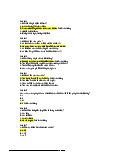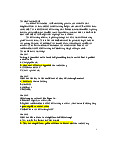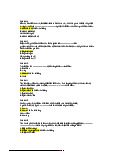








Preview text:
Score
Regional Unified Quarterly Assessment First Quarter SCIENCE 10 Name Date Section Division School
Direction: Encircle your best answer.
1. Where are most active volcanoes, earthquake epicenters, and major mountain belts found?
a. Randomly scattered across the globe.
b. Clustered along specific zones on Earth's surface.
c. Located primarily in the oceans.
d. Evenly distributed across continents.
2. Which of the following is NOT a major zone where these features are concentrated? a. Mid-Atlantic Ridge c. Interior of continents b. African Rift Valley d. Ring of Fire
3. What is one feature associated with earthquake epicenters?
a. They are all very deep underground.
b. They mark the location of a volcano.
c. The ground always moves upwards.
d. The shaking is strongest at the epicenter.
4. Which type of plate boundary is most associated with the formation of major mountain belts? a. Divergent boundary c. Transform boundary b. Convergent boundary d. Hotspot
5. What is the primary reason why the Pacific Ring of Fire has a high concentration of active volcanoes?
a. Presence of transform faults
c. Subduction of oceanic plates b. Frequent earthquakes d. Hotspot activity 1
6. Earthquake epicenters are often aligned along specific regions of the Earth's
surface. Which feature is most associated with these epicenters? a. Mid-Ocean ridges c. Fault lines b. Ocean trenches d. Hotspots
7. Major mountain belts, such as the Himalayas, are formed due to specific tectonic
processes. Which plates' collision led to the formation of the Himalayas?
a. Pacific and North American Plates
b. South American and African Plates c. Indian and Eurasian Plates
d. Australian and Antarctic Plates
8. The global distribution of active volcanoes provides insights into tectonic activity.
What is the most common feature of areas with a high concentration of active volcanoes?
a. They are located near the center of tectonic plates.
b. They are near or along tectonic plate boundaries.
c. They are found in regions of continental rift zones.
d. They are found in areas with ancient, stable landmasses.
For items 9-11. The Earth's crust is made up of large, tectonic plates that move slowly
over time. The boundaries between these plates are zones where geological activity is concentrated.
9. What happens at a divergent plate boundary?
a. New crust is created as the plates move apart, often accompanied by volcanic activity.
b. Plates push against each other, forming trenches and mountain ranges.
c. Plates slide past each other horizontally, causing earthquakes.
d. One plate subducts beneath another, melting rock and forming volcanoes.
10. How does the movement of plates at divergent boundaries differ from their
movement at convergent boundaries?
a. At divergent boundaries, plates move apart creating new crust, while at convergent
boundaries, plates push together, crumpling existing crust or subducting one plate under another.
b. Convergence always involves the formation of deep ocean trenches, while divergence does not.
c. Divergent boundaries are associated with mountain building, while convergent boundaries are not.
d. The movement is similar at both boundaries, just the outcome (landforms) differs.
11. Why are earthquakes more common at transform plate boundaries compared to divergent boundaries?
a. Friction between the plates sliding past each other builds up pressure, eventually
releasing as earthquakes. Divergent boundaries lack this friction.
b. Transform boundaries are associated with volcanic activity, which triggers
earthquakes. Divergent boundaries have less volcanic activity.
c. The molten rock at divergent boundaries acts as a lubricant, preventing earthquakes.
d. The presence of deep ocean trenches at convergent boundaries absorbs the energy that would cause earthquakes.
For items 12-14. Earth's lithosphere is divided into several plates that interact with each other.
12. What is the term for the boundary between two tectonic plates? a. Fault line b. Plate margin c. Rift valley d. Subduction zone
13. What type of plate boundary occurs when two plates slide past each other horizontally? a. Convergent boundary c. Transform boundary b. Divergent boundary d. Collision boundary
14. Which type of plate boundary is associated with the formation of mid-ocean ridges? a. Convergent boundary c. Transform boundary b. Divergent boundary d. Collision boundary
For items 15-19. Plate boundaries are regions where two tectonic plates meet and
interact, leading to various geological features and activities.
15. Which type of plate boundary is characterized by two plates moving away from each other? a. Convergent boundary c. Transform boundary b. Divergent boundary d. Subduction zone
16. At which type of plate boundary do two tectonic plates slide past each other horizontally? a. Divergent boundary c. Transform boundary b. Convergent boundary d. Rift valley
17. What geological feature is commonly formed at a convergent boundary between two continental plates? a. Mid- Ocean ridge c. Mountain range b. Ocean trench d. Volc anic Island arc
18. What type of plate boundary is typically associated with the formation of new oceanic crust? a. Convergent boundary c. Transform boundary b. Divergent boundary d. Subduction zone
19. Which type of plate boundary involves one tectonic plate being forced beneath
another, often leading to volcanic activity? a. Convergent boundary b. Divergent boundary c. Transform boundary d. Rift valley
For items 20-24. The movement and interaction of tectonic plates at their boundaries
shape the Earth's surface and are responsible for many geological phenomena.
20. What processes occur at plate boundaries that significantly impact the Earth's surface?
a. Plates diverge, converge, or transform, leading to volcanic activity, earthquakes,
mountain formation, and ocean trench creation.
b. Plate boundaries are mostly inactive and have minimal effect on the Earth's surface.
c. The main process at plate boundaries is the grinding of plates, which smooths rocks.
d. Plate boundaries primarily affect the ocean floor.
21. What is the main consequence of plates moving apart at a divergent boundary?
a. Formation of deep ocean trenches
b. Subduction of one plate under another
c. Creation of new crust, often accompanied by volcanic activity
d. Increased pressure leading to earthquakes.
22. What type of landform is created by the horizontal movement of plates grinding
past each other at a transform plate boundary? a. Mid-ocean ridges c. Mountain ranges b. Deep ocean trenches d. Large fault lines
23. How does the type of plate boundary (divergent, convergent, transform) affect volcanic activity?
a. Divergent boundaries typically have fewer explosive eruptions, while convergent
boundaries with subduction zones produce more frequent, volatile-rich volcanic
activity. Transform boundaries usually lack volcanic activity.
b. Volcanic activity is similar across all types of plate boundaries, regardless of their type.
c. Convergent boundaries experience the most intense volcanic activity due to the
collision of thicker continental crust.
d. Transform boundaries produce the most explosive volcanic eruptions due to high pressure buildup.
24. Earthquakes are a common phenomenon along plate boundaries. How do the
processes at convergent boundaries differ from those at transform boundaries,
leading to earthquake characteristics?
a. Convergent boundaries experience compressional earthquakes due to the pushing
together of plates. Transform boundaries experience shearing earthquakes due to
the horizontal grinding motion.
b. Both boundaries experience similar types of earthquakes, but convergent
boundaries have stronger tremors due to the larger forces involved.
c. Earthquakes at convergent boundaries are shallow, while those at transform boundaries are deep.
d. The presence of water at convergent boundaries dampens earthquake intensity
compared to transform boundaries.
For items 25-28. Tectonic plates interact with each other at their boundaries.
25. How does the type of plate boundary influence the formation of landforms?
a. Landforms are unrelated to plate boundaries
b. Divergent boundaries only form mountains
c. Convergent boundaries create all landforms
d. Different plate boundaries produce different landforms
26. How do the processes occurring at plate boundaries relate to the distribution of
earthquakes and volcanoes?
a. Earthquakes and volcanoes are randomly distributed
b. Plate boundaries have no impact on earthquake and volcano distribution
c. All plate boundaries produce earthquakes and volcanoes
d. Different plate boundaries have different relationships with earthquakes and volcanoes
27. How does the rate of plate movement affect the intensity of geological processes at plate boundaries?
a. Plate movement speed has no impact on geological processes
b. Faster plates always produce more intense processes
c. Slower plates lead to more intense geological processes
d. The relationship between plate speed and geological processes is complex
28. How does the interaction between tectonic plates and the Earth's mantle
influence geological processes at plate boundaries?
a. The mantle has no role in plate boundary processes
b. The mantle is only involved in volcanic activity
c. The mantle drives plate movement and influences boundary processes
d. The relationship between the mantle and plate boundaries is unknown
For items 29-33. Various geological processes occur along the boundaries of tectonic
plates, resulting in the formation of different features and natural events on Earth.
29. What process typically occurs at a divergent boundary between two oceanic plates? a. Mountain formation c. Subduction b. Seafloor spreading d. Earthquake
30. Which process is most likely to occur at a convergent boundary where an oceanic
plate meets a continental plate? a. Oceanic ridge formation
c. Subduction and volcanic activity b. Mountain building d. Rift valley formation
31. At a transform boundary, what is the most common geological event? a. Earthquake c. Mountain formation b. Volcano formation d. Seafloor spreading
32. Which process occurs at a convergent boundary between two continental plates?
a. Formation of volcanic islands
c. Formation of mountain ranges
b. Formation of deep ocean trenches d. Formation of mid-ocean ridges
33. What geological feature is formed at a divergent boundary between two continental plates? a. Volcanic island arc c. Ocean trench b. Rift valley d. Fold mountains
For items 34-38. The Earth is a dynamic planet with a layered internal structure.
34. What is the outermost layer of the Earth, where we live and build our cities? a. Mantle b. Outer core c. Inner core d. Outer core
35. The mantle is the thickest layer of the Earth. What is its state (solid, liquid, or gas)? a. Gas b. Liquid
c. Solid (mostly) with some plastic-like behavior d. Completely molten
36. The Earth's core is extremely hot. Is the outer core solid or liquid? a. Solid c. Gas b. Liquid
d. It varies depending on location
37. How does the difference in temperature and pressure between the mantle and
the core affect their states (solid vs. liquid)?
a. The high temperature in the core keeps it liquid, while the mantle, under immense
pressure, remains mostly solid despite its high temperature.
b. The mantle is liquid due to the presence of molten rock rising from the core. The
core cools and solidifies under pressure.
c. Both the mantle and core are in similar liquid states due to the extreme heat.
d. The mantle is cooler and more solid than the core because it radiates heat outwards.
38.The crust and the mantle are considered to be part of the same tectonic system,
while the core is distinct. Explain why.
a. The crust and mantle share similar solid (or mostly solid) states and interact
through plate tectonics. The core, being liquid, behaves differently.
b. The composition of the crust and mantle is similar, while the core is made of denser metals.
c. The crust is constantly being recycled through plate movement, while the mantle
and core remain relatively stable.
d. All the above contribute to the distinction between the crust/mantle system and the core.
For items 39-41. The Earth is composed of several layers with distinct characteristics.
39. How does the density of Earth's layers vary from the core to the crust?
a. Density increases from core to crust
b. Density is constant throughout the Earth
c. Density increases from crust to core
d. Density varies randomly throughout the Earth
40. How does the Earth's internal heat affect the movement of tectonic plates?
a. Internal heat has no impact on plate movement
b. Internal heat cools the plates, slowing them down
c. Internal heat provides energy for plate movement
d. Internal heat has an unpredictable effect on plate movement
41. How does the study of seismic waves provide information about the Earth's internal structure?
a. Seismic waves cannot penetrate the Earth's interior
b. Seismic waves are unaffected by Earth's layers
c. Seismic waves are used to directly observe the Earth's core
d. Seismic waves are used to infer the properties of Earth's layers
For items 42-45. The Earth is composed of several layers, each with distinct
characteristics and compositions that play a vital role in the planet's geological activity.
42. Which layer of the Earth is the hottest and composed mainly of iron and nickel? a. Crust b. Mantle c. Outer core d. Inner core
43. What is the Earth's outermost layer called? a. Crust b. Mantle c. Outer core d. Inner core
44. Which layer of the Earth is responsible for the movement of tectonic plates? a. Crust b. Mantle c. Outer core d. Inner core
45. The Earth's core is divided into two parts. What distinguishes the outer core from the inner core?
a. The outer core is solid, and the inner core is liquid.
b. The outer core is liquid, and the inner core is solid.
c. Both the outer core and inner core are liquid.
d. Both the outer core and inner core are solid.
For items 46-50. The Earth's tectonic plates are constantly moving, albeit slowly.
Scientists are still investigating the exact cause of this movement.
46. What is the layer of the Earth located directly beneath the tectonic plates,
believed to be a key factor in plate movement? a. Crust b. Outer core c. Inner core d. Mantle
47. The theory of plate tectonics explains the movement of large plates that make
up the Earth's crust. What are some of the possible mechanisms driving this movement?
a. Convection currents in the Earth's mantle, where hot, molten rock rises, cools, and
sinks, creating a cyclical movement that drags plates along.
b. The gravitational pull of the sun and moon on the Earth's surface, causing the plates to shift.
c. The Earth's rotation creating a centrifugal force that pushes plates apart at the equator.
d. The cooling and shrinking of the Earth's core, causing the outer layers to wrinkle and fold.
48. The theory of plate tectonics suggests hot, molten rock moves within the mantle.
What happens to this hot rock as it rises towards the surface?
a. It cools and sinks back down, creating a circulation pattern.
b. It vaporizes and escapes into the atmosphere.
c. It solidifies and becomes part of the crust.
d. It remains hot and molten all the way to the surface.
49. The force of gravity plays a role in many phenomena on Earth. Does gravity play
a part in plate movement according to plate tectonics?
a. No, gravity is not a significant factor in plate tectonics.
b. Yes, gravity pulls the plates down, but convection currents are the main driver.
c. Yes, the gravitational pull of the sun and moon influences plate movement.
d. The answer is unclear; the role of gravity is still being debated.
50. How do convection currents in the mantle influence tectonic plate movement?
a. Convection currents create a cycle where hot mantle rock rises and spreads,
moving plates at the surface, while cooler rock sinks, dragging plates at subduction zones.
b. Convection currents primarily heat the mantle, expanding it and pushing plates apart.
c. The direct rising and sinking of mantle rocks push and pull tectonic plates across the surface.
d. Convection currents result from plate movement rather than causing it.




